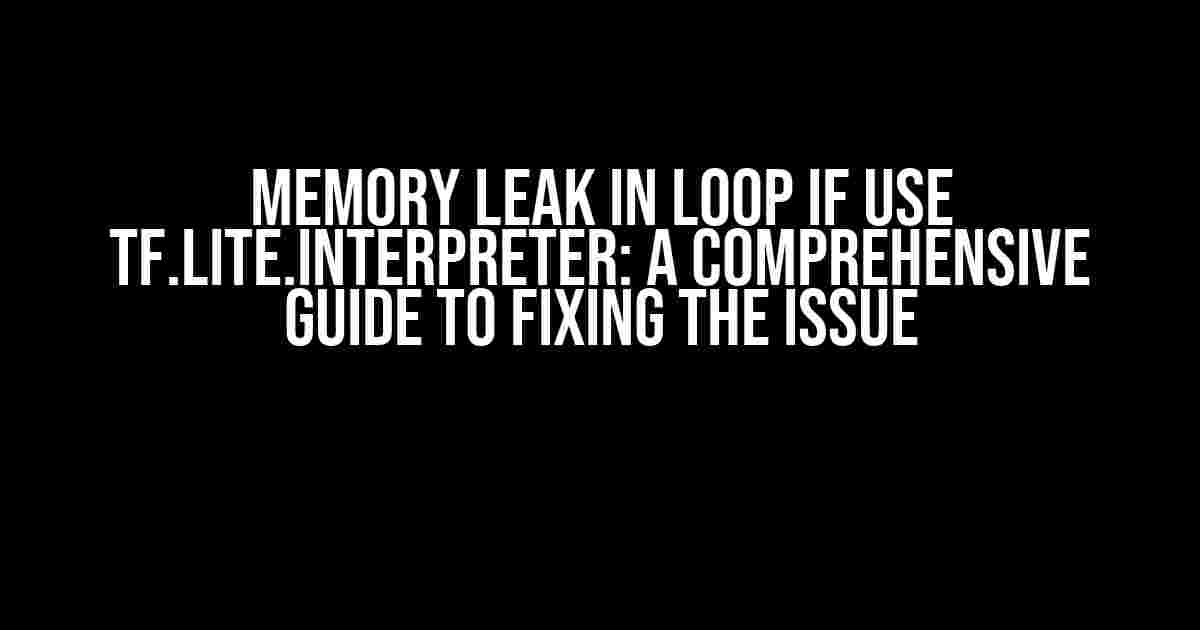Are you tired of dealing with memory leaks in your machine learning models? Do you find yourself stuck in an infinite loop of debugging, only to realize that the issue lies in the humble tf.lite.interpreter? Fear not, dear reader, for today we shall embark on a thrilling adventure to conquer the memory leak in loop conundrum and emerge victorious!
What is a Memory Leak?
Before we dive into the depths of the issue, let’s take a step back and understand what a memory leak is. A memory leak occurs when a program or application continuously allocates memory but fails to release it back to the system. This can lead to a gradual increase in memory consumption, ultimately resulting in crashes, slowdowns, or even system failures.
In the context of machine learning, memory leaks can be particularly problematic, as they can cause models to consume excessive resources, slow down training, and even lead to inaccurate results.
The Culprit: tf.lite.interpreter
So, what’s the deal with tf.lite.interpreter? Why does it seem to be the root cause of our memory leak woes? The answer lies in how TensorFlow Lite interpreters are designed to work.
When you create a TensorFlow Lite interpreter, it allocates memory to store the model’s weights, biases, and other data. However, when you use the interpreter in a loop, it doesn’t release the allocated memory after each iteration. Instead, it continues to accumulate memory, leading to a gradual increase in consumption.
This can be particularly problematic when working with large models or datasets, as the memory leak can quickly spiral out of control.
Symptoms of a Memory Leak
So, how do you know if you’re dealing with a memory leak in your TensorFlow Lite project? Keep an eye out for these common symptoms:
- Gradual increase in memory consumption over time
- Sudden spikes in memory usage during model inference
- Model training or inference taking longer than expected
- System crashes or freezes during model deployment
- Inaccurate or inconsistent model results
Fixing the Memory Leak
Now that we’ve identified the issue, it’s time to put on our debugging hats and fix the memory leak once and for all! Here are some tried-and-true methods to get you started:
Method 1: Reset the Interpreter
One simple way to fix the memory leak is to reset the interpreter after each iteration. This can be done using the `interpreter.reset()` method:
import tensorflow as tf
interpreter = tf.lite.Interpreter(model_path='model.tflite')
for i in range(100):
interpreter.reset()
interpreter.allocate_tensors()
interpreter.set_tensor(input_details[0]['index'], input_data)
interpreter.invoke()
output_data = interpreter.get_tensor(output_details[0]['index'])
# Process output data
By calling `interpreter.reset()` at the beginning of each iteration, you ensure that any allocated memory is released, preventing the leak.
Method 2: Use a Context Manager
Another approach is to use a context manager to ensure that the interpreter is properly cleaned up after each iteration. You can create a custom context manager using the `contextlib` module:
import contextlib
import tensorflow as tf
@contextlib.contextmanager
def tf_lite_interpreter(model_path):
interpreter = tf.lite.Interpreter(model_path)
try:
yield interpreter
finally:
interpreter.delete()
for i in range(100):
with tf_lite_interpreter('model.tflite') as interpreter:
interpreter.allocate_tensors()
interpreter.set_tensor(input_details[0]['index'], input_data)
interpreter.invoke()
output_data = interpreter.get_tensor(output_details[0]['index'])
# Process output data
By using a context manager, you ensure that the interpreter is properly cleaned up after each iteration, preventing any memory leaks.
Method 3: Use a Single Interpreter Instance
If you’re using the interpreter in a loop, consider creating a single instance of the interpreter and reusing it for each iteration. This can help mitigate the memory leak:
import tensorflow as tf
interpreter = tf.lite.Interpreter(model_path='model.tflite')
interpreter.allocate_tensors()
for i in range(100):
interpreter.set_tensor(input_details[0]['index'], input_data)
interpreter.invoke()
output_data = interpreter.get_tensor(output_details[0]['index'])
# Process output data
By reusing the same interpreter instance, you avoid the need to create and destroy multiple instances, which can help reduce memory consumption.
Best Practices to Prevent Memory Leaks
To avoid memory leaks in the first place, follow these best practices:
- Use a context manager or reset the interpreter**: Ensure that you properly clean up after each iteration to prevent memory accumulation.
- Reuse interpreter instances**: Create a single instance of the interpreter and reuse it for each iteration to reduce memory consumption.
- Monitor memory usage**: Keep an eye on memory consumption during model training and inference to catch any potential leaks early on.
- Profile your model**: Use profiling tools to identify performance bottlenecks and optimize your model for better memory usage.
- Regularly update your TensorFlow version**: Ensure you’re running the latest version of TensorFlow, as newer versions often include memory leak fixes and improvements.
Conclusion
In conclusion, memory leaks in loops when using tf.lite.interpreter can be a frustrating issue, but with the right techniques and best practices, you can conquer this problem and ensure your machine learning models run smoothly and efficiently.
Remember to reset the interpreter, use a context manager, or reuse interpreter instances to prevent memory leaks. By following these guidelines and staying vigilant, you’ll be well on your way to creating robust and reliable machine learning models.
| Method | Description |
|---|---|
| Reset the Interpreter | Call `interpreter.reset()` at the beginning of each iteration to release allocated memory. |
| Use a Context Manager | Use a context manager to ensure the interpreter is properly cleaned up after each iteration. |
| Reuse Interpreter Instances | Create a single instance of the interpreter and reuse it for each iteration to reduce memory consumption. |
Stay tuned for more exciting articles on machine learning and TensorFlow, and don’t forget to share your own experiences and tips on dealing with memory leaks in the comments below!
Frequently Asked Question
Get answers to the most frequently asked questions about memory leak in loop when using tf.lite.interpreter.
Q: What is a memory leak, and how does it relate to tf.lite.interpreter?
A memory leak occurs when a program or application continuously consumes memory but fails to release it, leading to performance issues and even crashes. When using tf.lite.interpreter, a memory leak can happen if the interpreter is created or allocated repeatedly within a loop, causing the memory usage to increase gradually.
Q: Why does the memory leak occur in a loop when using tf.lite.interpreter?
The memory leak occurs because the tf.lite.interpreter object is not properly deallocated after each iteration, causing the memory to accumulate. This is often due to the interpreter being created within a loop, and the Python garbage collector is not able to release the memory promptly.
Q: How can I prevent a memory leak when using tf.lite.interpreter in a loop?
To prevent a memory leak, create the tf.lite.interpreter object outside the loop and reuse it within the loop. This ensures that the interpreter is only allocated once and reused multiple times, preventing memory accumulation.
Q: Are there any other ways to mitigate memory leaks when using tf.lite.interpreter?
Yes, apart from reusing the interpreter, you can also consider using the Python garbage collector to manually release the memory. Additionally, you can use tools like tensorflow’s built-in memory profiler to identify and debug memory leaks.
Q: What are the consequences of not addressing a memory leak when using tf.lite.interpreter?
If left unaddressed, a memory leak can lead to performance degradation, slow down the application, and even cause it to crash. In severe cases, it can also lead to system crashes or instability, making it essential to identify and mitigate memory leaks early on.


